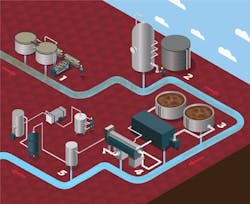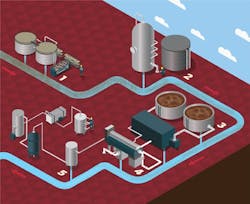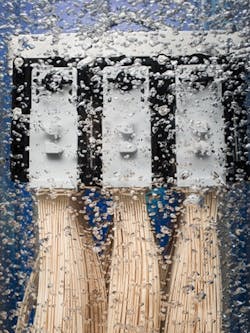Federated Co-operatives Limited’s Co-op Refinery Complex (CRC) in Regina, Sask., is one of Canada’s largest and most productive refineries. The complex originally was established in the 1930s by a group of eight farmers as a more economical way to supply fuel to a small chain of Saskatchewan farmer-owned gas stations. The facility’s output has grown from 500 bbl/d in 1935 to 130,000 bbl/d today, making it one of Western Canada’s major fuel suppliers.
Water is critical to sustaining CRC operations. The refinery requires an average of 1,600 gal/min of water for steam generation; the steam is used for heating, hydrogen production, cooling towers and for powering equipment. The facility is one of the single largest freshwater consumers in Regina, drawing water from on-site groundwater wells and receiving supplies from the city’s municipal system during periods of high demand.
When the CRC increased its operations several years ago, raising production from 100,000 bbl/d to 130,000 bbl/d, the Water Security Agency (WSA), the provincial body responsible for water supply and use, mandated that the CRC find a new source of water to support the expansion.
Figure 1. Refinery relies on five treatment stages for its wastewater.
Regina has an arid climate. So, water conservation and demand management play significant roles in addressing the area’s water scarcity challenges. Embracing responsible water usage and responding to the WSA’s requirement, the CRC committed to a C$200 million “environmental mega project” and water recycling initiative — referred to as the wastewater improvement project (WIP) — to enable the refinery to reuse 100% of its wastewater.
To meet this ambitious water recycling target, the WIP would need to be capable of high levels of wastewater treatment to remove solids, oils, phenols, nitrogen compounds, organics and other contaminants. Treated water then would require demineralizing to allow its use in steam production. Further sustainability and environmental objectives included eliminating the release of volatile organic compounds (VOCs) from wastewater ponds, phasing out the use of municipal treated water and reducing demand for groundwater.
CRC decided to partner with SUEZ Water Technologies & Solutions on the project. SUEZ, which helped design, build and commission the WIP, incorporated a variety of advanced processes and proprietary treatment technologies. The WIP was commissioned in mid-2015 and has treated refinery waste since November 2015. The demineralization plant has been completed and tested; it should be in continuous operation by the end of the second quarter of this year.
Multistage System
The WIP design features five treatment stages (Figure 1) and uses a range of SUEZ technologies.
Stage 1 — Wastewater tanks and oily water separators. Wastewater initially goes to holding tanks where oil and water are separated by gravity. Floating oil is skimmed from the top of the wastewater and subsequently reprocessed within the refinery. Wastewater then passes to another tank where sediment and oily sludge sink to the bottom. The oil is sent back to the refinery for reprocessing while the sludge is removed and disposed of safely.
Figure 2. Following treatment in a membrane bioreactor, water goes to hollow-fiber membranes.
Stage 2 — Dissolved gas flotation unit. Wastewater continues to stage 2 — a SUEZ Poseidon dissolved gas flotation unit. Here, microscopic nitrogen bubbles pumped into the wastewater bind to suspended oil particles. The bubbles cause the remaining oil particles to float to the surface where they are removed for reprocessing in the refinery. This stage uses SUEZ’s PolyFloc AE1701 chemistry as a flocculant.
Stages 3 and 4 — Membrane bioreactor (MBR) and centrifuge. Following separation, the wastewater goes to an MBR. First, biological treatment breaks down VOCs and ammonia in the water. Then, the water is filtered using SUEZ’s ZeeWeed 500 ultrafiltration hollow-fiber membranes (Figure 2). This combined treatment creates a permeate. Stage 3 utilizes SUEZ’s BioPlus BA2970 and BioPlus BA3900 chemistry for biological seeding and bioaugmentation in the biological reactor, and FoamTrol AF3031 for foam control there.
Stage 4 consists of a centrifuge to separate the bioreactor’s excess biomass, with bacteria then returned to the bioreactor. A small amount of water also is extracted and reprocessed; the leftover solid biomass is disposed of safely. SUEZ’s Novus CE2655 chemistry serves as a flocculant in the centrifuge.
Stage 5 — Demineralization plant. The permeate from stage 3 largely is free of organics, ammonia, nitrites, nitrate and other impurities. It undergoes further treatment in a demineralization plant in preparation for steam production. The plant features SUEZ’s High pH RO system, which consists of ion exchange units for hardness reduction and a decarbonator to remove alkalinity and carbon dioxide. High pH RO is unique in its ability to effectively run at a very high recovery, under high organic loading, without fouling or frequent cleaning.
This stage prepares the recycled water for steam production by removing high levels of dissolved solids such as calcium, magnesium, chlorides and sulfates. Following treatment, the permeate takes a second pass through another RO unit to polish the water. Finally, a mixed-bed ion exchanger eliminates undesirable ions to produce ultrapure water suitable for steam production. Figure 3 shows the wastewater before and after treatment.
Figure 3. Samples show wastewater before and after treatment.
The WIP also takes advantage of SUEZ’s InSight asset performance management system, which combines advanced data and analytics to ensure wastewater treatment assets operate optimally. For instance, InSight monitors the performance and long-term health of the ZeeWeed membranes. InSight also tracks the operation, chemistry and overall product quality between stages — monitoring the removal of solids, oils and greases across stage 2, and closely evaluating the quality of water leaving stage 3 to ensure it’s on spec to reuse during stage 5. Moreover, InSight watches chemical use, dosage ranges, and tank inventories to check that chemicals are dosed correctly, ordered when needed and always available.
Impressive Results
Thanks to leading-edge wastewater treatment technologies from SUEZ, the CRC became the first refinery in North America to treat all its effluent on-site, eliminating wastewater discharge. Today, the facility recovers 2 million gal/d of wastewater, the majority of which is used in its steam plant. The WIP has cut the refinery’s freshwater needs by 28% — equivalent to the annual water usage of approximately 3,100 Regina households. By decreasing the CRC’s reliance on raw water from the local aquifer and the city’s municipal system, the WIP also ensures that the refinery’s draw from groundwater supplies complies with regulated allocations.
The combination of live bacteria, special filtration units and SUEZ’s advanced High pH RO technology decreases VOC emissions and nuisance odors from the CRC’s wastewater ponds, significantly reducing the refinery’s environmental footprint.
JOHN ELLIOTT, PE, is Oakville, Ont.-based industrial sales manager for Canada for SUEZ Water Technologies & Solutions. Email him at [email protected].



